
12 minute read
Record
the outcomes, stories of the craftspeople
The record stage intends to document all the work done during various stages of the self-initiated challenge. It used varied mediums to record the activities happened during the project. This is done through photographic documentation, video recordings, scanning of exploratory sketches, 3-d recording of the products. During the Community Driven Innovation project undertaken at Gundiyali, each stage was carefully recorded and documented.
Advertisement
The outcomes of each sessions, were recorded using the doc box developed as part of the project. This part will be further explored in detail with the Kala Kosh phase of the project.





disseminate
through exhibition and public discussions
Once all the outcomes of the self-initiated challenge were recorded and categorized, the next step is to disseminate them. Dissemination can be done through various mediums: exhibitions, publications, videos and a variety of print and online mediums. Dissemination is important, because it gives a platform for all the stakeholders to connect to the public. It also acts a stage where reflection happens from both the organisers and participants and which is later fed in the forthcoming programs.
Dissemination also becomes crucial as this is the stage which connects the craft community to varied experts ranging from fellow craftspeople, designers, industry experts, entrepreneurs, academicians and society at large.
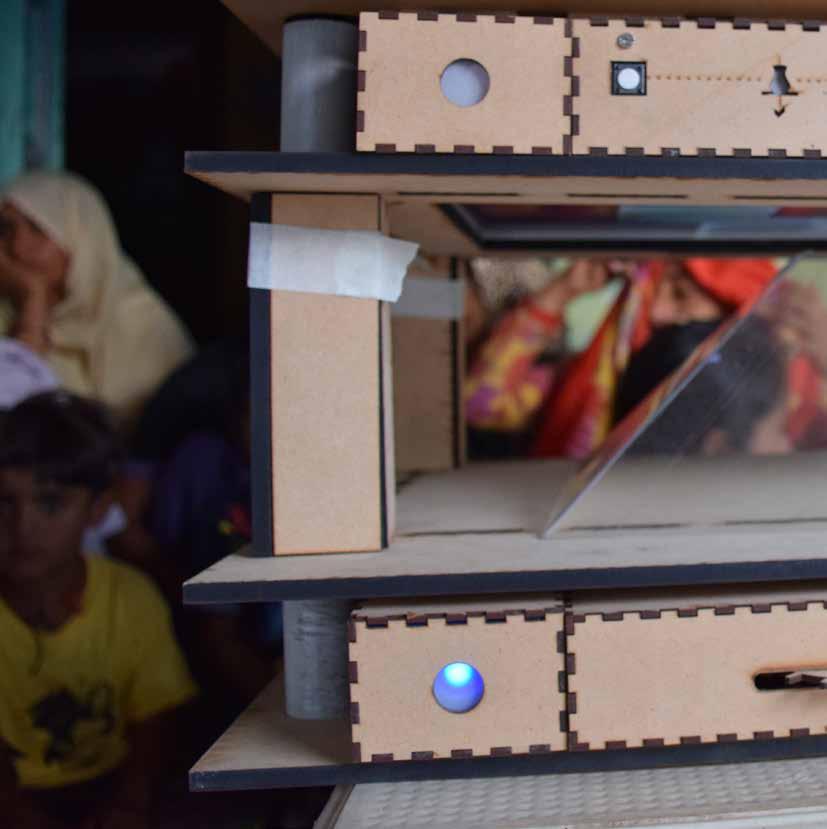
Kala-Kosh






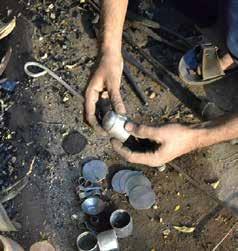

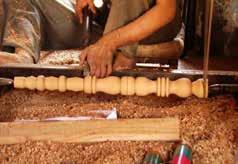

about
Technological advancement has been constantly opening up exciting and enhanced possibilities to interact with people, objects and spaces. New technologies are immensely changing our ways of learning. From various field experiences we may infer that the traditional craft communities have remained unaware and ignorant of new technologies. In India, traditional crafts and practices have always remained important to sustain the living heritage and livelihood of many communities.
Through this project we are trying to explore possibilities of enhancing traditional crafts with the introduction of new technologies. Kala Kosh exploration is an experiment with traditional potters of Gundiyali, Kutch. This project is supported by Ford Foundation and National Institute of Design, India and is in collaboration with DICRC, CEPT University.

field research
The collaboration of DICRC and the craft community at Gundiyali has been a successful ongoing project which aided in choosing this project. Project was divided into three stages: first stage of the project is the field visit, understand the craft cluster and generate multiple ideas as per broad goal of project.
The second stage revolved around one central idea. Based on the study and interests of the craftsmen the idea of Kala Kosh was established and a prototype was discussed.
The third phase of the project was to install the prototype at the village for long durations and was given to the craft community for various observations which were recorded and analysed. A weeklong field research and interaction with the community was initiated.
Modules for Kala Kosh :
Module I DocBox for documenting products and storing into archive Module II ViewBox for viewing products from archive in a 3d hologram
Kala Kosh : Possibile Impact
Store and View all creations at one place See skills improving
Preserve digital artifacts even if it is sold or broken Triggers to practice and innovative more
Retail Stores Museums/Exhibits Online Channels
Keep Connected
Kala Kosh
digital archive Storage Viewing
Community Level Value in Future Digital Repository of Artifacts of community
Inspiration for upcoming generation of craft community
Enables community sharing Enables cmmunity learning Collective community growth Help the craft Sustain in community
the idea
The idea is about enabling artisans of Gundiyali to make a digital archive for their artefacts and explore all possibilities to enhance their craft practices. The idea of the digital archive gave rise to questions such as:
How can they preserve an identical copy of the artefact? What kind of possibilities an archive would create? How user friendly is this archive? What does such enhancement mean to the artisan? Can new technologies inspire the upcoming generation of craft practitioners?
Setting up the Kala Kosh prototype answers to these questions would be explored.
Making and setting up of basic prototype :
Planning for Basic Prototype


Testing
Demonstrating Idea of Kala Kosh to artisans of Gundiyali :
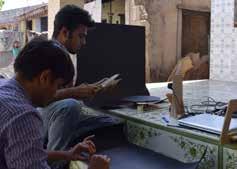
Setting up at Gundiyali
Demonstration


Setup and hologram of a scanned object
Discussion with artisans
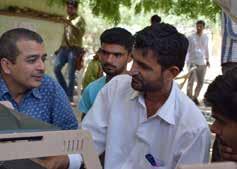
Discussing working of prototype


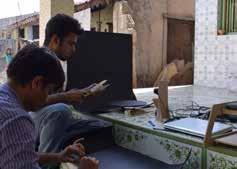
Artisan capturing his prototype demonstration
prototype
In order to develop the idea further it was essential to interact with the artisans regarding the prototype being a part of their daily life. Firstly, a basic prototype was set up at Gundiyali which was demonstrated to the artisans. The basic prototype was to make digital version of artefacts which translated into 3 dimensional holograms. Prototype was in its raw version so the artisans were exposed to the electronic components. Prototype was built using open source technologies like Arduino and Processing.
After the demonstration, the artisans were curious to know how the prototype would work, what would be the cost? How would one use it without any computing knowledge? Based on the questions asked the research team could easily conclude that the artisans were convinced. The curiosity of the young artisans gave rise to an improved design.
Kala Kosh Detailed Prototype Design DocBox : Docuementation Module ViewBox : View Module
This module contains a turntable, camera and card identification modules and a button.
When artisans want to store new object this box is where they place object and identitifcation card and press the button to start the storage process. .
Storing objects in archive :
This module is a display unit. While storing new objects it works as a demo display. While viewing objects it shows object in three sided hologram and with information of artisan/maker.
1 Place Object Insert Id Card Step 1 2 Press Start & View Box will show live view from camera 1 Check name, object, size 2 Confirm & start process Step 2 Stop Saving Process
prototype design
A detailed prototype design was developed and introduced to the community. Kala Kosh prototype design included multiple aspects from physical forms, electronics, programming, user interface design and other aspects like identification of artisan and hologram display.
A simple manual was designed for the ease of installation. •This module contains a turntable, camera and card identification modules and a button. The artisans could store new objects by placing the object on the turntable and an identification card would be inserted at the slot provided and press the button to start the storage process. •This module is the display unit. While storing new objects it works as a demo display While viewing objects it displays object in three sided hologram and with information of the respective artisan/maker.
Designing and making of detailed Prototype

Planning for a detailed prototype Prototype development started in with developing each module


Testing coordination of programs, mechanical parts and electronics
Designing and assembling various physical controls with electronics

Testing all modules, programs and electronic components


Customizing Raspberry Pi for easy start and setting up auto cloud backup
Making Kala Kosh modules using digital fabrication

Final integrating of all components

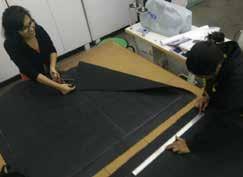
Making case for the DocBox module
prototype making
On completion of a detailed prototype, multiple iterations of design of forms and user interaction design was made available. As artisans were not familiar with computing technologies an extremely simple user interface design was attempted. Open source technologies and digital fabrications accelerated the making of prototype. The members contributed were diverse with their respective field expertise. Integration of modules and panels were composed into two boxes. Many rounds of testing took place to ensure all errors were resolved and the Kala Kosh project remains in a resolved state.
Setting up detailed prototype of Kala Kosh
Storing new product in Kala Kosh
Kala Kosh Modules

Viewing products in Kala Kosh
next step
People of varied expertise contributed towards the completion of the Kala Kosh prototype. Integration of modules and panels were composed into two boxes. Many rounds of testing took place to ensure that all errors were resolved and Kala Kosh installation was narrowed down to teo units.
Kala Kosh is an ongoing research project and it will be installed at Gundiyali. Different identity cards will be provided to the craftsmen and a workshop will be organized for demonstration and the prototype will be tested for different scenarios. Field testing and observations will take place and impact analysis will be done. The artisans feedback will dictate the final design.

Project disseminationMaker fest


about
Maker Fest is the Indian continuation of Maker Faire hosted across America, Europe, Africa and Japan. Maker Faire, which launched in California in 2006, now hosts hundreds of thousands attendees. It is the amalgamation of festivals celebrating the innovators and an art show with booths for inventors, demonstrations, and workshops for attendees.
Stretching from every corner of India, Maker Fest is about developing a great maker community where people can learn and share about making. Creators, artists and hobbyist across the country are invited to present their contemporary applications of ideas using the vast ocean of art, science and technology. We welcome the entire maker community in India to come together to ideate, build and share.
The community of Gundiyali as one entity came together to showcase their techniques and ideas. The fest was a 3 day event that brought together the making community of diverse fields.





demonstration
The 3 day event gave the urban fabric complete access to meeting the artisans. The aim was to rekindle the dying pottery art. The public was exposed to the making of the mud art.
With the guidance of the artisans, different kinds of pots of various sizes were made by the people themselves. The idea was to initiate interaction, sharing of ideas and to arrive at a final product. The potters curated the exhibition, giving them a glimpse of an entire new set up. Essentially, with the help of a demonstration unit the interaction was elevated. 2 demonstration units were set up to cater to the multitude of people.
The products that were as a result of the Self -Initiated Challenge model were displayed alongside with individual cards of the potters with their contact and respective expertise information. This was a step to bridge the gap that exists between the public and the artisans.





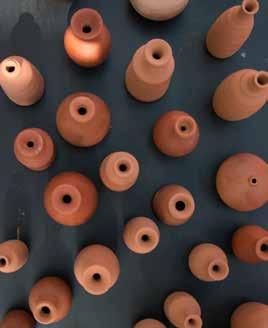






digital archive
The Maker Fest become a stage that brought together two ends of the design spectrum: Arts and Technology. In collaboration with National Institute of Design and Ford Foundation, a digital archive was established.
The Digital archive comprised of a 3 dimensional holographic display was used as a tool for the artisans to document the mud products that they worked on. This unit of display would work in favor of the farmers in case the products were misplayed or broken, they could revert back to this display unit.
The display unit is a prototype set up. However, the prototype would be subjected to improvisation dictated by the convenience of the artisans. This prototype on final approval will be installed at Gundiyali for the ease of documentation.
notes
DICRC is supported by Industrial Extension Cottage (iNDEXT-c), Government of Gujarat, India. iNDEXT-c is a State Government Scheme under Cottage and Rural Industries (Commissioner of Cottage Industry).
Design Innovation and Craft Resource Centre (DICRC), CEPT University, Ahmedabad To know more, visit the official website : www.dicrc.in Contact : +91-7265800050, email: dicrc@cept.ac.in










